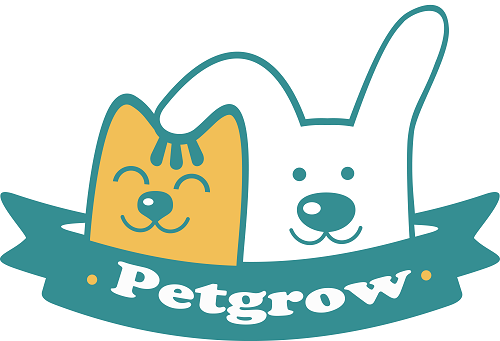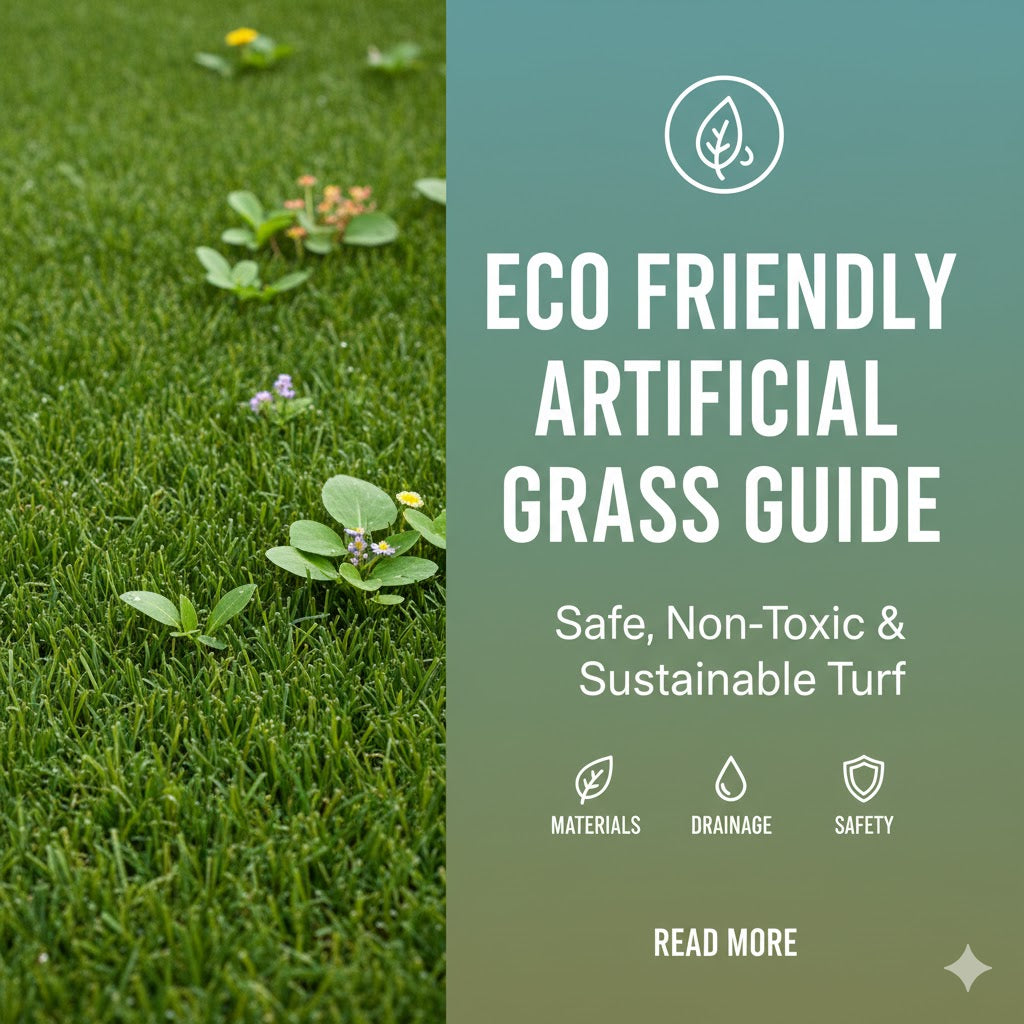When choosing eco-friendly artificial grass, you want something that saves water and cuts down on hard work. You don’t need to mow, fertilize, or use chemicals. That means less time maintaining your yard and less harm to the planet.
Still, some turf products are not as safe as they seem. A few use plastics or coatings that can release chemicals into soil or water. Others can’t be recycled when replaced. Knowing these details helps you avoid greenwashing and make a better choice.
A safe and eco-friendly lawn should protect your family, pets, and the environment. It should last for years and still look great in every season.
What Makes Eco Friendly Artificial Grass “Eco” and Safe?
Not every kind of turf is truly green. Real eco friendly artificial grass is made from safe materials and built to last without harming the planet.
A good turf should not release toxic chemicals or microplastics into the soil or water. It should also have a low carbon footprint during the manufacturing process. Some brands use plant-based materials like soybean oil or sugar cane instead of petroleum. These materials make recycling easier and cut pollution.
Look for grass that includes recycled content or comes from recycled materials. Some companies even offer take-back or recycling programs that help reuse old turf. This supports a circular economy, where waste becomes new products instead of landfill trash.
Eco Friendly Artificial Grass — A Quick Decision Checklist
Before buying, take a few minutes to check if the turf is truly safe. Real eco friendly artificial grass should meet these key points:
- No harmful chemicals — Make sure it’s non toxic and lead free. Avoid turf that doesn’t list materials or safety tests.
-
No rubber infill — Skip styrene-butadiene rubber or crumb rubber. Choose organic infill made from cork or coconut, or go infill-free.
-
Recyclable design — Pick turf made from one type of plastic, like polyethylene or polypropylene. This helps increase its recycling rate later.
-
Safe drainage system — Look for drainage holes, a strong backing, and a good stormwater management setup to stop water buildup.
-
Heat and UV resistance — Ask for details about UV protection, weather resistance, and expected lifespan.
- Trusted standards — Choose brands with clear quality labels, like ISO 9001 or LEED certification, to confirm high safety and environmental care.

Materials to Look For in Eco Friendly Artificial Grass
When buying eco friendly artificial grass, the materials tell you how safe and sustainable it really is. Good turf uses cleaner and longer-lasting components.
Bio-Based and Low-Toxic Materials
Some newer turfs are made with plant-based materials such as sugar cane or soybean oil. These replace petroleum and lower the turf’s carbon footprint. Look for brands that list biobased polymers or soy-based components in their product details. They release fewer toxic chemicals and are safer for kids and pets.
Recycled and Recyclable Construction
Choose turf that includes recycled content or uses recycled materials. Even better, find a brand with a clear recycling solution or a take-back program. Many now support a circular economy, turning old turf into new products instead of dumping it in landfills.
Strong and Safe Yarn Types
The top layer of turf, called the “yarn,” affects both look and safety. Pick yarn made from UV-resistant PP material or UV-resistant PE to stop fading and reduce heat. A Texturized PP thatch or “Mini W” shape keeps the blades springy and realistic.
What to Avoid When Choosing Eco Friendly Artificial Grass
Eco friendly artificial grass sounds like the perfect green choice, but not every product lives up to the name. Some types still harm the environment. Knowing what to avoid helps you choose turf that’s truly safe.
Rubber or Plastic Infills
Stay away from turf that uses styrene-butadiene rubber or crumb rubber. These materials break down into microplastics and wash into soil and drains. They can harm plants, animals, and waterways. Pick organic infill made from cork, coconut fiber, or sand instead.
Hidden Chemicals
Some products hide toxic chemicals in their coatings, glues, or dyes. These can release fumes or leak into the ground. Always ask for proof that the turf is non toxic and lead free. If a company won’t share safety reports, skip it.
Non-Recyclable Layers
Avoid turf that mixes different materials, like latex or polyurethane. These layers make recycling hard and add more waste to landfills. Choose turf made from a single, recyclable material like polyethylene or polypropylene.
If you’re choosing turf for pet areas, explore our guide on organic infill options safe for dogs.

How Eco Friendly Artificial Grass Handles Heat, Water & Storms
Good eco friendly artificial grass is built to handle hot sun, heavy rain, and even strong winds. But not all products perform the same, so it’s smart to check a few details before buying.
Heat and Comfort
Artificial grass can get hot under the sun. Some turf can reach over 150°F on a summer day. Look for products made with heat absorbent or UV-resistant PP material. Lighter colors reflect sunlight and stay cooler. Adding shade or rinsing the turf with water also helps lower surface heat.
Drainage and Stormwater Management
A quality turf should drain water fast. Check for drainage holes, Quadruple hole punched backing, or full Water Permeability ratings. These let rain flow through instead of pooling. A good sub-base made of crushed rock or gravel helps water soak into the ground and supports better stormwater management.
Water Conservation
Unlike natural grass, turf doesn’t need regular watering. You’ll only rinse it sometimes to clean dust or pet mess. That means big water conservation and lower water bills. Many cities with water conservation policies now support turf for this reason.
Installation Tips to Get the Most from Eco Friendly Artificial Grass
Installing eco friendly artificial grass the right way helps it last longer and work better. A good setup keeps it safe, clean, and eco-friendly from day one.
Prepare the Base
Start by clearing the area. Remove old grass, rocks, and weeds. Lay down a weed barrier to stop new weeds from growing through the turf. Add a layer of crushed rock or gravel. This helps with drainage and keeps water from sitting under the surface.
Secure the Turf
After the base is level, roll out your turf. Make sure all pieces face the same direction. Use landscape staples or nails to hold the edges firmly. If you need extra support, add a ground anchor peg around corners and seams.
Seam and Fit Properly
Cut the turf to fit the area. Use seam tape and low-VOC glue to join pieces together. Press down the seams tightly so the turf looks smooth and natural.
Choose Safe Infill or None
If your turf needs infill, go for organic options like cork or coconut fiber. Avoid rubber crumbs or styrene-butadiene rubber. For small lawns or pet dog areas, you can skip infill altogether.
Spec Sheet — How to Read Labels for Eco Friendly Artificial Grass
Before you buy eco friendly artificial grass, take time to read the product label. It tells you how the turf is made and how long it will last.
Pile Height and Yarn Type
The pile height is how tall the grass blades are. Shorter blades feel firm and work well for play or pet dog areas. Taller blades look softer for home lawns. The Face Yarn Type matters too. Look for UV-resistant PP or polyethylene yarns. They stay green longer and resist fading.
Backing and Drainage
Check what holds the turf together. A strong backing keeps it from tearing. Quadruple hole punched backing or built-in drainage holes let water pass through easily. That helps prevent puddles and supports better stormwater systems.
Safety and Quality Labels
Look for non toxic, lead free, and ISO 9001 on the label. These show that the product meets safety and quality standards. Some brands list LEED certification points or ESG reports to prove they follow sustainable practices.
Weather and UV Protection
Good turf should resist sun, rain, and heat. Check for UV protection and weather resistance details. These keep your turf from breaking down early and save money over time.
Cost, Maintenance & Longevity
Buying eco friendly artificial grass can cost more at first, but it saves money over time. You don’t have to mow, water, or buy fertilizer. That means lower bills and less work all year.
Upfront vs. Long-Term Cost
The price depends on the quality and size of your yard. While installation may be higher than natural grass, the savings add up over the years. You’ll use less water, less energy, and fewer lawn tools, which reduces your carbon footprint.
Simple Maintenance
Turf doesn’t need much care. Brush it once a month to keep the blades standing up. Rinse it when it gets dusty or after pets use it. Use mild soap and water for spills. Avoid harsh cleaners that may damage the fibers.
Long Lifespan
Most high-quality turf lasts 10 to 20 years. Choose turf with UV-resistant PP material and strong backing for the best results. Regular cleaning and care help it stay fresh, safe, and green season after season.

Conclusion
Choosing eco friendly artificial grass is about more than just looks. It’s about creating a yard that’s safe for your family and gentle on the planet.
When you pick turf made from recycled or plant-based materials, you help reduce waste and save water. By avoiding toxic chemicals and planning for recycling later, you make sure your choice stays green from start to finish.
Remember to buy from trusted brands that share clear safety and quality details. A well-installed, well-cared-for turf can stay fresh, soft, and strong for many years.


Share:
How to Choose the Best artificial infill for dogs? A Full Comparison
What are the benefits of artificial grass for my yard and pets?